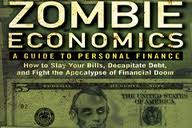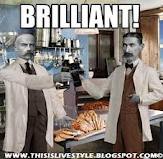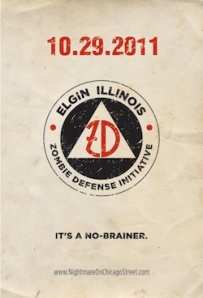 This morning I awoke to a present in my email inbox. My good friend and fellow-blogger at One World One Plate, Marissa Garza, gave me a +K point in the topic area of “non-profit” on Klout. I know some of you may be wondering “What is Klout?” In a nutshell, it is a website that measures your influence in the social media world through the use of a complicated algorithm. There are a number of different measurement instruments including an “overall Klout score” based on a scale of 1 to 100. My current score is 42 and Marissa’s +K point helped bump my score up a little.
This morning I awoke to a present in my email inbox. My good friend and fellow-blogger at One World One Plate, Marissa Garza, gave me a +K point in the topic area of “non-profit” on Klout. I know some of you may be wondering “What is Klout?” In a nutshell, it is a website that measures your influence in the social media world through the use of a complicated algorithm. There are a number of different measurement instruments including an “overall Klout score” based on a scale of 1 to 100. My current score is 42 and Marissa’s +K point helped bump my score up a little.
I know what some of you are thinking . . . this is a passing fad . . . this is a subjective measurement gimmick . . . or even “uh-oh” another social media thing to suck my time.
My response to all of these reactions is: “Let’s not be so quick to rush to judgment on this one”. After playing with Klout for a few months, here are a few conclusions I’ve reached:
- Many non-profit friends ask me how they should measure the “return” on their resource development investment when it comes to social media (e.g. Twitter, Facebook, LinkedIn, Google+, blogging, etc). Well, Klout is the first tool I’ve seen that begins to answer this question. So, now non-profits can invest their resource development time, energy, and money with peace of mind that they can measure the return.
- Going beyond the idea of measuring ROI, Klout gives non-profits a barometer when it comes to social media efforts (e.g. similar to analytics tools attached to websites, blogs, and email marketing services). If what you’re Tweeting or posting on Facebook or blogging isn’t being looked at and shared, then your Klout score will reflect it. So, as your Klout score drops, you’ll be able to stop doing those things that aren’t being well received and start Tweeting and posting other things that might be better received. It is kind of like “being in a donor’s head” . . . something every fundraising professional has periodically wished for.
- Going beyond ROI and measurement, I think I’ve become enamoured by Klout mostly because it allows you see other people’s and agency’s Klout scores. While this site probably appeals to the social media voyeurism in all of us, I encourage you to embrace this feeling. So, one non-profit can look for another non-profit who has a higher Klout score. Once they find someone who is similar to them (e.g. budget size, approach to resource development, social media savvy, etc) and who has a higher Klout score, then they have the ability to start benchmarking that agency. I oftentimes end my blogs by saying something like “We can all learn from each other”. Well, Klout embraces this idea and I must admit that I LOVE IT. Click here to read a post by NonProfit Nate and see who the top non-profits are on Twitter based on their Klout scores.
OK . . . I am done braggin’ on Klout and I encourage you to sign up (because it is FREE). You don’t need to go wild from the start. I know how busy many of you are. So, just sign-up and visit your Klout page once per week for approximately 30 seconds. Watch your Klout score (and other various metrics) and marinade on what you see happening. When you are ready to start doing something about the numbers, your “inner fundraising voice” will tell you.
You might also want to bookmark some of these links and circle back from time-to-time and read up on Klout:
- Wild Apricot blog: “Got Klout? Great Twitter Metrics for Nonprofits”
- Dutiee blog: Klout: Increase Your Nonprofit’s Influence across Social Media Networks”
- NpTalk: “What’s Your Klout? Is Measuring Online Influence Valuable to Your Organization?”
Is your agency dabbling in social media? If so, what are your objectives? How are you measuring your success? Can you share any anecdotal stories about donors you acquired online who have since migrated into other areas of your resource development program? What kind of things are you Tweeting and posting? What material seems to be well-received?
Please weigh-in using the comment box below. We can all learn from each other. Please take 30 seconds to share.
Here is to your health! Oh yeah . . . I am not beneath begging my readers for some more +K points. 😉 Please?
Erik Anderson
Founder & President, The Healthy Non-Profit LLC
www.thehealthynonprofit.com
erik@thehealthynonprofit.com
http://twitter.com/#!/eanderson847
http://www.facebook.com/eanderson847|
http://www.linkedin.com/in/erikanderson847
















